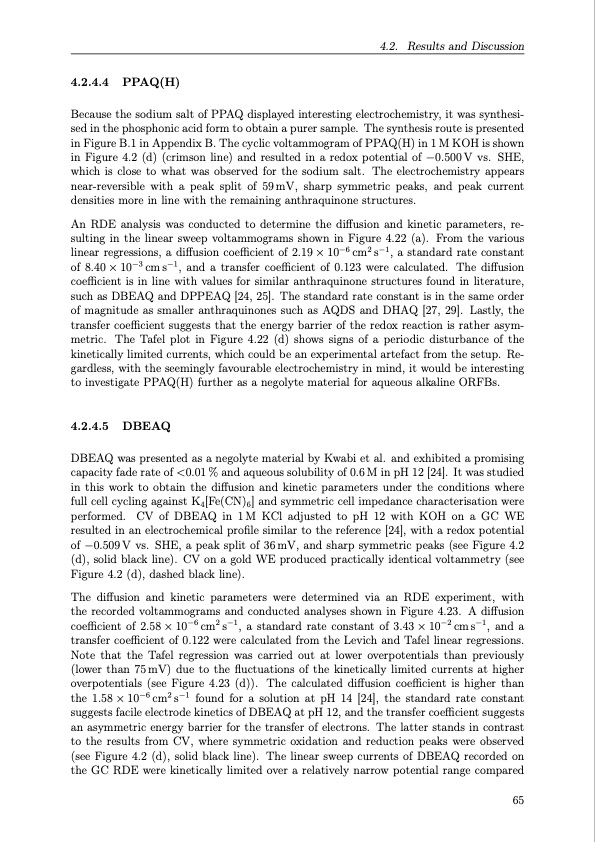
PDF Publication Title:
Text from PDF Page: 086
4.2.4.4 PPAQ(H) Because the sodium salt of PPAQ displayed interesting electrochemistry, it was synthesi- sed in the phosphonic acid form to obtain a purer sample. The synthesis route is presented in Figure B.1 in Appendix B. The cyclic voltammogram of PPAQ(H) in 1 M KOH is shown in Figure 4.2 (d) (crimson line) and resulted in a redox potential of −0.500V vs. SHE, which is close to what was observed for the sodium salt. The electrochemistry appears near-reversible with a peak split of 59mV, sharp symmetric peaks, and peak current densities more in line with the remaining anthraquinone structures. An RDE analysis was conducted to determine the diffusion and kinetic parameters, re- sulting in the linear sweep voltammograms shown in Figure 4.22 (a). From the various linear regressions, a diffusion coefficient of 2.19 × 10−6 cm2 s−1, a standard rate constant of 8.40 × 10−3 cm s−1, and a transfer coefficient of 0.123 were calculated. The diffusion coefficient is in line with values for similar anthraquinone structures found in literature, such as DBEAQ and DPPEAQ [24, 25]. The standard rate constant is in the same order of magnitude as smaller anthraquinones such as AQDS and DHAQ [27, 29]. Lastly, the transfer coefficient suggests that the energy barrier of the redox reaction is rather asym- metric. The Tafel plot in Figure 4.22 (d) shows signs of a periodic disturbance of the kinetically limited currents, which could be an experimental artefact from the setup. Re- gardless, with the seemingly favourable electrochemistry in mind, it would be interesting to investigate PPAQ(H) further as a negolyte material for aqueous alkaline ORFBs. 4.2.4.5 DBEAQ DBEAQ was presented as a negolyte material by Kwabi et al. and exhibited a promising capacity fade rate of <0.01 % and aqueous solubility of 0.6 M in pH 12 [24]. It was studied in this work to obtain the diffusion and kinetic parameters under the conditions where full cell cycling against K4[Fe(CN)6] and symmetric cell impedance characterisation were performed. CV of DBEAQ in 1M KCl adjusted to pH 12 with KOH on a GC WE resulted in an electrochemical profile similar to the reference [24], with a redox potential of −0.509 V vs. SHE, a peak split of 36 mV, and sharp symmetric peaks (see Figure 4.2 (d), solid black line). CV on a gold WE produced practically identical voltammetry (see Figure 4.2 (d), dashed black line). The diffusion and kinetic parameters were determined via an RDE experiment, with the recorded voltammograms and conducted analyses shown in Figure 4.23. A diffusion coefficient of 2.58 × 10−6 cm2 s−1, a standard rate constant of 3.43 × 10−2 cm s−1, and a transfer coefficient of 0.122 were calculated from the Levich and Tafel linear regressions. Note that the Tafel regression was carried out at lower overpotentials than previously (lower than 75mV) due to the fluctuations of the kinetically limited currents at higher overpotentials (see Figure 4.23 (d)). The calculated diffusion coefficient is higher than the 1.58 × 10−6 cm2 s−1 found for a solution at pH 14 [24], the standard rate constant suggests facile electrode kinetics of DBEAQ at pH 12, and the transfer coefficient suggests an asymmetric energy barrier for the transfer of electrons. The latter stands in contrast to the results from CV, where symmetric oxidation and reduction peaks were observed (see Figure 4.2 (d), solid black line). The linear sweep currents of DBEAQ recorded on the GC RDE were kinetically limited over a relatively narrow potential range compared 4.2. Results and Discussion 65PDF Image | Organic Redox Flow Batteries 2023

PDF Search Title:
Organic Redox Flow Batteries 2023Original File Name Searched:
PhD_thesis_final_dorhoff_4_.pdfDIY PDF Search: Google It | Yahoo | Bing
Salgenx Redox Flow Battery Technology: Salt water flow battery technology with low cost and great energy density that can be used for power storage and thermal storage. Let us de-risk your production using our license. Our aqueous flow battery is less cost than Tesla Megapack and available faster. Redox flow battery. No membrane needed like with Vanadium, or Bromine. Salgenx flow battery
| CONTACT TEL: 608-238-6001 Email: greg@salgenx.com | RSS | AMP |